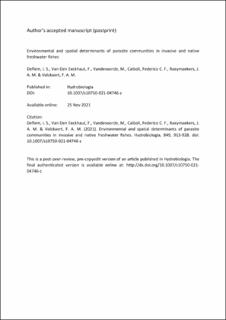Environmental and spatial determinants of parasite communities in invasive and native freshwater fishes
Deflem, Io S.; Van Den Eeckhaut, Frederik; Vandevoorde, Mikaël; Calboli, Federico C.F.; Raeymaekers, Joost A.M.; Volckaert, Filip A.M.
Peer reviewed, Journal article
Accepted version

Åpne
Permanent lenke
https://hdl.handle.net/11250/2982210Utgivelsesdato
2021Metadata
Vis full innførselSamlinger
Originalversjon
Deflem, I. S., Van Den Eeckhaut, F., Vandevoorde, M., Calboli, F.C.F., Raeymaekers, J.A.M. & Volckaert, F.A.M. (2021). Environmental and spatial determinants of parasite communities in invasive and native freshwater fishes. Hydrobiologia, 849, 913-928. doi: 10.1007/s10750-021-04746-zSammendrag
Understanding why certain host species harbor more parasites is an important question in parasite and fish ecology. Parasite infection among sympatric species may integrate various processes affecting parasite assembly, including the species-specific ecology and the success of invaders. We focused on spatial, environmental, and host-related determinants of parasite assembly in three riverine fish species: the native three-spined stickleback and stone loach, and the invasive topmouth gudgeon. Parasite community structure differed significantly between the three host species. Three-spined stickleback harbored the most ectoparasites. Host density and nutrients were the strongest predictors of its parasite communities. Topmouth gudgeon harbored the lowest number of parasites, both in terms of abundance and species richness. None of the parasites identified originated from its expanded range, suggesting that enemy release occurred during invasion. Temperature and host density predicted parasite assemblages of topmouth gudgeon. Stone loach hosted the most endoparasites, likely resulting from its varied diet, benthic lifestyle, and larger size. Additionally, host size and condition were positively correlated with parasite infection, which was similar among the three host species. The results suggest that host-related factors have a similar effect among host species, while the importance of environmental and spatial factors differs according to host ecology.